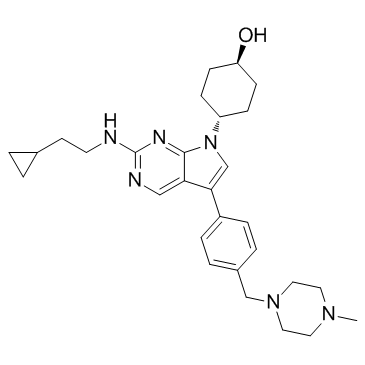MRX-2843 (UNC2371) (Synonyms: UNC2371) |
| Catalog No.GC32769 |
MRX-2843 (UNC2371) (UNC2371) is an orally active, ATP-competitive dual MERTK and FLT3 tyrosine kinases inhibitor (TKI) with enzymatic IC50s of 1.3 nM for MERTK and 0.64 nM for FLT3, respectively.
Products are for research use only. Not for human use. We do not sell to patients.

Cas No.: 1429882-07-4
Sample solution is provided at 25 µL, 10mM.
MRX-2843 is an orally available small-molecule inhibitor of both MERTK and FLT3.
In the Kasumi-1 cell line, treatment with MRX-2843 results in dose-dependent inhibition of MERTK phosphorylation. Decreased phosphorylation is evident at concentrations as low as 10 nM, with near-complete abrogation of MERTK activation at 100 to 300 nM. Similarly, treatment of Kasumi-1 cells with MRX-2843 mediates inhibition of downstream signaling through pathways important for tumor cell survival and proliferation. MRX-2843 treatment results in a decrease in relative cell numbers, with an IC50 of 143.5±14.1 nM, indicating that MRX-2843 significantly inhibits tumor cell proliferation and/or survival. Similarly, there are 34.1%±5.6% and 67.1%±2.7% apoptotic and dead cells in NOMO-1 cultures treated with 150 nM or 300 nM MRX-2843, respectively, compare with 6.8%±0.7% in vehicle-treated cultures (P<0.001). Treatment with 50 nM and 100 nM MRX-2843 results in 62.3%±6.4% and 84.1%±7.8% inhibition of colony formation, respectively, in Kasumi-1 cultures (P<0.01). Similarly, in NOMO-1 cultures, colony formation is inhibited by 54.8%±18.1% in response to treatment with 100 nM MRX-2843 (P<0.001). In MOLM-14 cells, treatment with MRX-2843 inhibits phosphorylation of FLT3 and downstream signaling through STAT5, ERK1/2, and AKT. Activation of FLT3 and its signaling pathways is almost completely abrogated by treatment with 50 nM MRX-2843, indicating somewhat higher cellular potency against FLT3 relative to MERTK[1].
MRX-2843 is 78% orally bioavailable at a dose of 3 mg/kg with a Cmax of 1.3 μM and a t1/2 of 4.4 hours. In MOLM-14 parental xenografts, both quizartinib and MRX-2843 increase median survival compare with that of vehicle-treated mice (172.5 days versus 40 days and 121 days versus 36 days, respectively, P<0.001). In this model, quizartinib is more effective than MRX-2843 (P<0.005), although higher doses of MRX-2843 are not evaluated. In MOLM-14:D835Y xenografts, quizartinib prolongs survival compare with that of vehicle-treated mice, but the effect is minimal (median survival 45 days vs. 36 days, P<0.001). In MOLM-14:F691L xenografts, treatment with MRX-2843 prolongs survival by almost 2-fold in NSG and NSGS mice (median survival 87 vs. 44.5 days and 87 vs. 48 days, respectively, P<0.005). Increased survival is observed in response to treatment with MRX-2843 versus quizartinib, but the difference is only significant in NSG mice[1].
[1]. Minson KA, et al. The MERTK/FLT3 inhibitor MRX-2843 overcomes resistance-conferring FLT3 mutations in acute myeloid leukemia. JCI Insight. 2016 Mar;1(3):e85630.
Average Rating: 5 (Based on Reviews and 20 reference(s) in Google Scholar.)
GLPBIO products are for RESEARCH USE ONLY. Please make sure your review or question is research based.
Required fields are marked with *




















